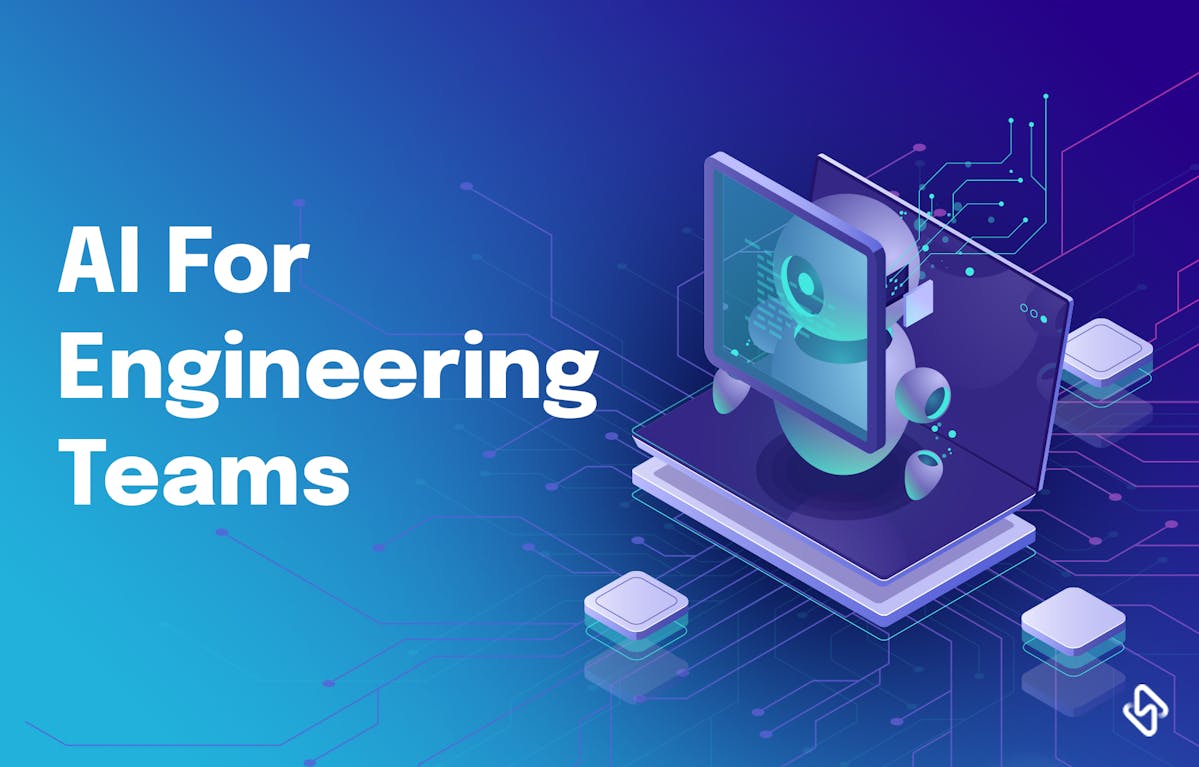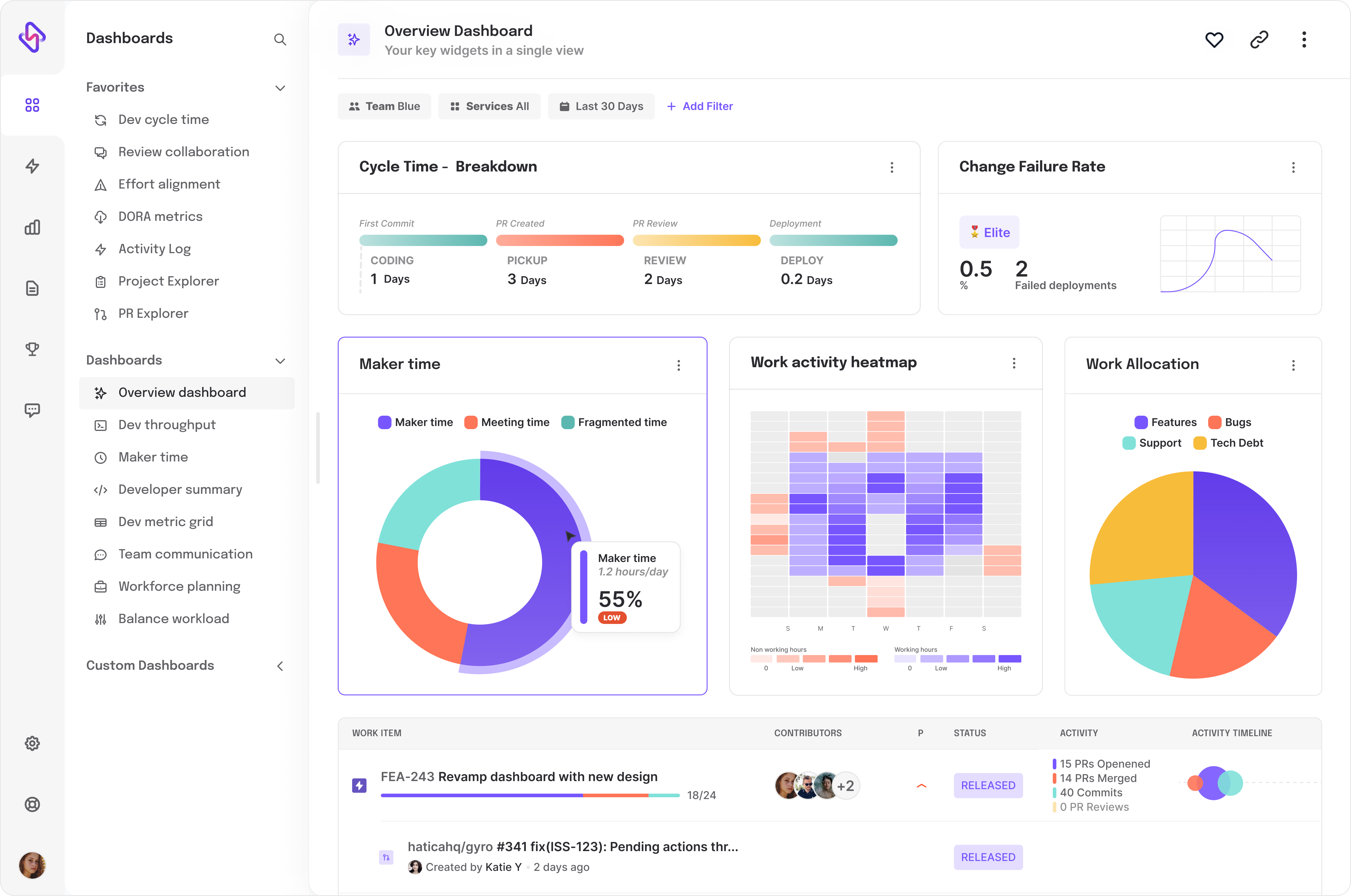1. AI-Driven Code Review
One of the prominent use cases of AI in SDLC is AI-driven code review. Traditional code reviews are painful, time-consuming and may overlook subtle issues. AI-powered tools can analyze code quickly and comprehensively, providing developers with valuable insights and suggestions for improvement.
These tools can detect code bugs, and security vulnerabilities, improving code over time, and ensuring that the software is robust and reliable. Moreover, review tools like Reviewable combine AI analytics, with a human touch by automatically organizing reviews into groups, and suggesting contextual code changes.
Software teams can leverage automatic code regeneration capabilities to swiftly create efficient and reliable software based on previous successful designs. Through all these, developers can quickly identify or predict technical performance and issues before finalizing architectural designs. Example use cases of AI code review tools include Copilot, CodeClimate, and DeepCode.
2. Predictive Maintenance with AI
As AI continues to evolve, so does the potential of Predictive Maintenance. By analyzing historical data and patterns, AI algorithms can predict software failures and defects before they occur.
The integration of IoT devices, 5G connectivity, and edge computing will enable even more real-time data analysis. GenAI simplifies predictive maintenance via:
- Reliability & availability: No more unexpected breakdowns ruining your day. AI keeps your assets running smoothly, ensuring you're always on top of your game.
- Safety & quality: With GenAI, minimize chances of human errors and accidents. AI's got your back, making sure everything's shipshape, accident-free, and defect-free
- Cost savings: Watch those dollars pile up as AI optimizes maintenance, slashes waste, and makes your equipment last longer.
3. Automated Testing and QA
Automated testing is another area where AI shines. AI-powered testing tools can execute test cases at scale, identify defects, and provide comprehensive test coverage. This not only accelerates the testing process but also improves the overall quality of the software. AI-driven quality assurance ensures that the software meets the desired standards and specifications. Notable AI-powered testing tools include Testim and Applitools.
GenAI can also help you write efficient unit tests, and take acceptance testing to newer heights. AI-verified test cases are often more efficient and adheres to best practices. This allows developers to focus on higher-level tasks while AI handles the repetitive coding work.
Besides, AI-driven A/B testing lets you experiment with confidence. It automatically adjusts traffic distribution based on real-time performance data.
4. Documentation
Documentation is a critical aspect of the SDLC, and AI-powered Natural Language Processing (NLP) tools are making a big impact. In the age of smart everything, AI is taking the lead in crafting quality documentation.
NLP can automatically generate documentation, extract insights from textual data, and improve communication among team members. AI-driven NLP tools enhance the clarity and accuracy of documentation, making it easier for developers to understand and maintain the software.
Need data-driven insights? GenAI is here at your rescue! Crunch numbers, identify trends, and extract nuggets of knowledge- all prerequisites of smart documentation.
Real-world applications of NLP in SDLC documentation include auto-generating API documentation and analyzing user feedback. Say goodbye to hours wasted on tedious typing and formatting.
5. Intelligent Debugging
AI streamlines bug tracking and issue resolution in the SDLC. Intelligent systems can categorize and prioritize bugs, reducing the time and effort required for resolution.
AI doesn't just scan your code; it deciphers it. It's like having a super-smart co-pilot who spots issues you didn't even know existed. Code analysis? Check. Code comprehension? Double check. Moreover, GenAI also offers predictive bug hunting. Meaning AI can predict where bugs might pop up next.
AI-driven bug-tracking tools offer suggestions for fixing issues and help teams make data-driven decisions. Such tools improve collaboration among team members and ensure a smoother development process.
6. Deployments
GenAI helps engineering teams automate deployments, and shorten time to market. Moreover, based on retrospective analysis and historical trends, AI predicts the best times to roll out updates, and where the deployment process is as slick as a well-oiled machine. That's the world of AI-driven Continuous Deployment (CD).
Moreover, AI can also trigger rollbacks everytime anomalies appear, or error rates are high, and user engagement is low.
Another use-case of GenAI in deployments is predictive scaling, and a self-healing infrastructure. AI crunches the numbers, forecasts traffic spikes, and scales your app preemptively- No more downtime during unexpected traffic surges.
Your infrastructure evolves and adapts in real-time. AI spots bottlenecks, scales resources automatically, and ensures your app's performance is always top-notch.
7. Security, Compliance, and Threat Detection
AI doesn't just make deployment faster; it makes it more secure and compliant.
AI learns from patterns, identifies anomalies, and raises alarms in real-time before an attack wreaks havoc. These systems analyze network traffic, monitor system behavior, and identify anomalies that may indicate a breach. Real-world instances of AI thwarting security threats highlight the significance of AI in securing SDLC processes.
Compliance comes with a lot of headache, and engineering frictions for tech teams. AI ensures that your deployments meet industry standards and regulations, saving you from regular back and forth on compliance. From GDPR to HIPAA, AI tracks and enforces adherence.
AI goes beyond static rule-based systems. It learns the normal behavior of users and devices, instantly flagging unusual activities. Suspicious logins, data transfers, or access requests? AI's got you covered, spotting potential breaches before they escalate.
Threat detection too can be simplified using GenAI. Automated responses, such as isolating compromised systems or rerouting traffic can happen without devs having to keep their lights on always.
Strategise To Maximize The Value of GenAI
To further enhance AI use cases in the SDLC, organizations can consider the following strategies:
- Customization: Tailor AI solutions to the specific needs of your organization and projects. Customization ensures that AI tools align with your development processes and goals.
- Feedback Loops: Establish feedback loops to continuously improve AI models and algorithms. Collect feedback from developers, testers, and other stakeholders to refine AI-driven processes over time.
- Collaboration: Foster collaboration between AI experts and software development teams. Encourage cross-functional teams to work together to identify areas where AI can add the most value.
- Security and Privacy: Prioritize the security and privacy of data used by AI systems. Implement robust data protection measures and ensure compliance with data privacy regulations.
- Scalability: Consider the scalability of AI solutions. Ensure that AI-driven processes can accommodate the growing needs of your organization as it expands.
- User Training: Provide training and support to users of AI tools to maximize their effectiveness. Developers and other team members should be proficient in using AI-powered tools.
- Benchmarking: Regularly benchmark the performance of AI-driven processes against key metrics such as development speed, code quality, and security. Use these benchmarks to identify areas for improvement.
- Establish AI governance in your organization: Oversee the use of AI in the SDLC. These frameworks define roles, responsibilities, and policies for AI implementation, ensuring compliance with regulatory requirements.
- Foster continous learning: New standards encourage organizations to invest in ongoing AI education and training for their development teams. This ensures that AI technologies are used to their full potential and that developers stay updated with the latest advancements.
AI-Powered SDLC: Innovate, Optimize, Excel
As developers, we're not just coding; we're coding smarter, and faster. And GenAI makes the process smoother. From AI-driven code review to intelligent bug tracking and project management, AI is helping engineering teams deliver high quality software in record time, without anomalies, and bugs, so devs can focus more on creative work, and complex problem-solving.
AI models are more likely to augment the capabilities and productivity of development teams. AI can handle low-value, repetitive tasks that typically require extensive human intervention, performing them faster through automation. Developers, in turn, can focus on higher-value tasks such as critical thinking around business logic and algorithm optimization, working alongside AI models to accelerate development.
The integration of AI into the Software Development Life Cycle (SDLC) is not merely a technological trend, it is a strategic imperative for organizations aiming to stay competitive in the ever-evolving software industry.
Optimization is where AI flexes its computational muscles. It equips us to optimize every nook and cranny of our SDLC. From sprint planning to code deployment, AI provides data-backed insights that drive smarter decisions. It secures our codebase, ensures compliance, and guarantees peak performance. It's our partner in delivering software that not only satisfies but delights users.
The result? Faster, leaner, and cost-effective SDLCs.
FAQs
Generative AI (GenAI) can help boost your team's productivity and speed by at least 20-50%.
2. Can GenAI be used in SDLC?
Yes, GenAI can be used to automate several tasks, improve the quality of code, accelerate the software development process, and help instantly detect and fix errors.



